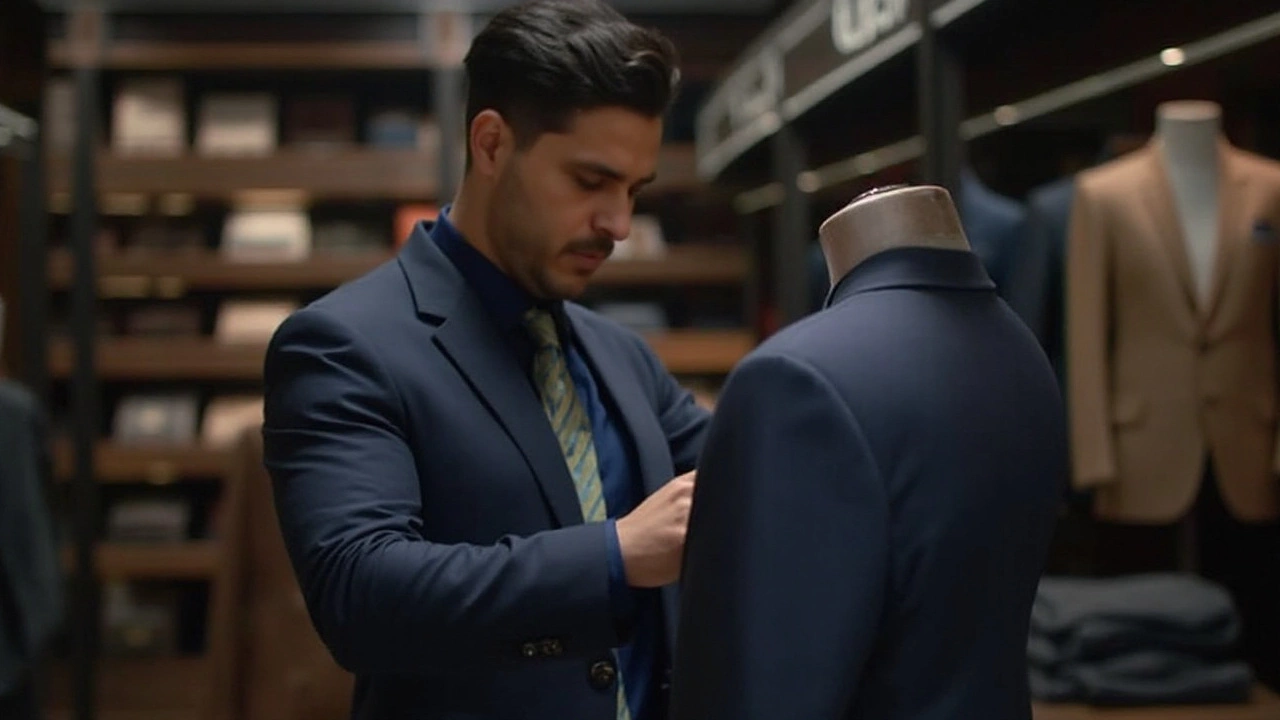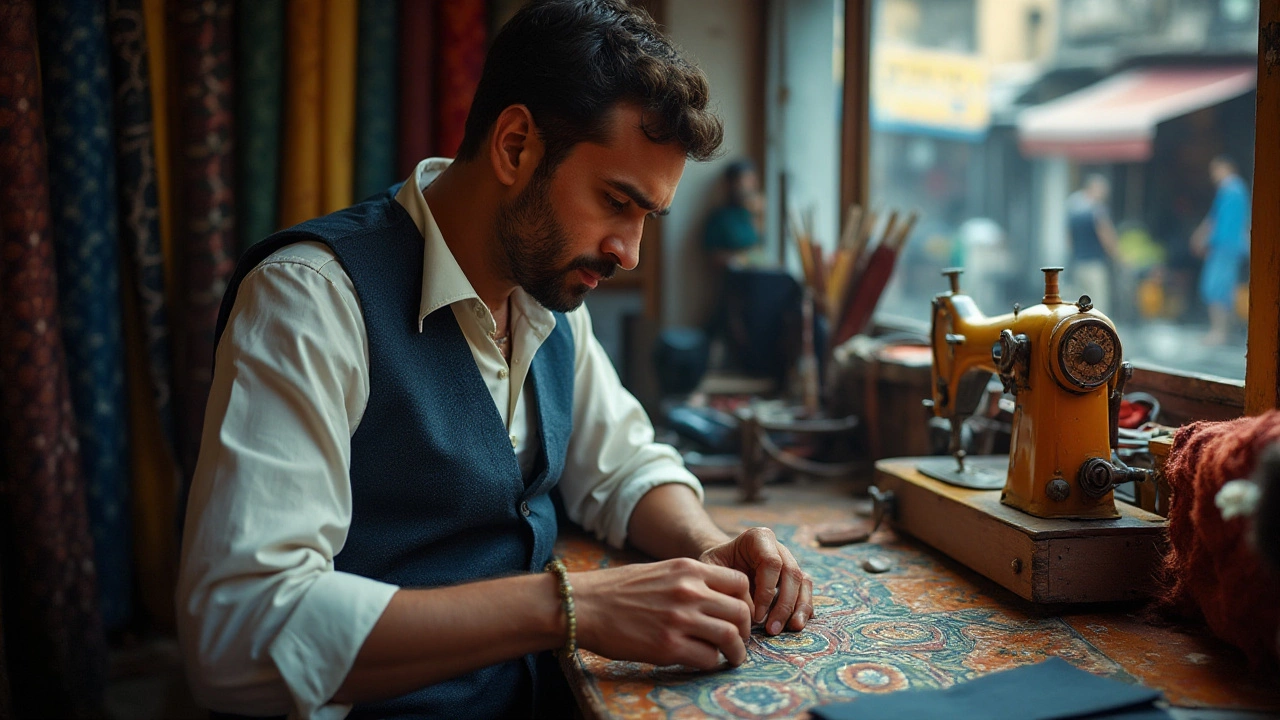Spotting a Cheap Suit: Tips for Quality Assessment

If you've ever wandered through the fashion aisles and pondered the essence of a well-crafted suit, you're not alone. When it comes to men's fashion, suits represent the cornerstone of elegance, but not all suits are created equal. Some wear their pricing on their sleeves, while others manage to conceal their cost beneath layers of thoughtful craftsmanship.
In a world brimming with an array of choices, understanding how to recognize a cheap suit can save you both bucks and sartorial embarrassment. It involves delving into the secret languages of fabric and threading, qualities that often hold the secrets to durability and style. Identifying these signs requires a discerning eye—a trained gaze on the subtleties that make or break a suit.
Buckle up as we unravel the mysteries of suit evaluation. From the fine textures of fibers to the meticulous attention in stitching, let's explore how to distinguish a merely flashy suit from one that truly stands the test of time. Whether you're preparing for a grand event or simply refreshing your wardrobe, this guide will equip you with the savvy needed to make a wise choice.
Fabric Quality
When considering the purchase of a mens suit, fabric quality reigns supreme. It forms the bedrock of any good garment, dictating both its comfort and durability. Natural fibers such as wool, cotton, and linen have long held the throne, revered for their breathability and resilience. Wool, especially, stands out as an icon of refinement in menswear – favored for its adaptability and ability to drape elegantly. There's also wool's intrinsic ability to moderate temperature, making it suitable for various climates. From the smoothness of worsted wool to the heft of a tweed, each type tells a story of sophistication and function, allowing wearers to tailor their choices to occasion and need.
Yet, one must be cautious, as not all wools are born equal. High twist yarns, for example, are indicative of neater, longer-lasting suits with a soft sheen and superior finish. Unfortunately, exploring the realm of luxurious fabrics often reveals that cheap suits cut corners by blending these esteemed fibers with synthetic materials like polyester or viscose. Blended fabrics might compromise the suit's feel and integrity over time. They often yield inferior performance, displaying wear and tear much quicker than their purebred counterparts. A well-informed suit buyer must check the fabric composition, ideally aiming for 100% wool or at least a high percentage.
In the quest for the perfect suit, one should not shy away from a tactile verification. Feeling the fabric between your fingers can tell you much about its quality—a luxurious fabric feels rich and substantial, while cheaper materials might come across as coarse or flimsy. A noteworthy aspect to ponder is the fabric's weight, as more substantial materials typically suggest higher durability. It's worth mentioning an old tailor's adage: "The weight of the cloth dictates the weight of the suit"—implying more durable fabrics hold better shape and are predisposed to defying the effects of gravity.
Sourcing is another vital chapter in this textile tale. Seek suits from reputable mills known for their ethical standards and quality outputs. 'Made in Italy' and 'Made in England' are prestigious labels often attached to the fabric, offering assurances of time-honored weaving traditions. Yet quality isn't mandated by geography alone, so verifying a manufacturer's reputation remains crucial. A keen understanding of these factors can protect the discerning gentleman from pitfalls that inexpensive fabrics might conceal under gaudy exteriors.
An intriguing insight from the sartorial world comes from the renowned fashion consultant Nick Porton, who noted, "Investing in a suit should feel like a commitment to craftsmanship. Each piece whispers tales of the artisans who create them and the fibers that come together to form a tapestry of elegance." His words echo a prevailing sentiment in the fashion industry—that fine fabric quality makes not just a suit, but an heirloom of style.
Finally, in the fabric quality realm, one must remember that beauty isn't just skin deep. Pay attention to these subtleties next time you're shopping for a mens suit. Look beyond the immediate allure and delve into the rich textures and hidden tales that each fabric holds. It is more than mere cloth; it is the lifeblood of your purchase, setting the tone for occasion, standing, and personal expression. So, when faced with myriad choices, arm yourself with knowledge, not just currency, and find that suit which feels like home.

Construction and Stitching
When it comes to assessing the quality of a men's suit, construction and stitching are often the secret tellers of the tale. Imagine peeling back the layers of a painting to appreciate the brushwork beneath; similarly, examining how a suit is put together can reveal a lot about its quality. The craftsmanship involved in a suit is the invisible thread that weaves together elegance and durability, two crucial components for your sartorial investment.
One of the most informative methods of understanding suit construction is to consider the interplay between different elements of a suit. For instance, a half-canvassed suit can feel like a warm embrace—perfectly snug yet allowing freedom of movement. It's a sweet spot, embodying structure without sacrificing comfort. You’ll often find such suits in what's considered the medium to higher price range, as they offer a balance between affordability and superior craft. Yet, even the allure of labels and names fades if the stitching fails. Attention to seams is central; a close stitch length, often unseen but felt through the smoothness of lines, reveals the dedication of its maker.
Suit quality tips also hinge upon noticing specific stitch types. For hand-finished pieces, look for subtle details, like the slight imperfection in hand-sewn pick stitching around the lapels and collar that adds to the suit’s character and strength. On the other hand, mass-produced suits generally lean on machine-sewn edges, which fine-tune efficiency over artistry. According to tailoring experts often quoted in GQ magazine, "A hand-sewn garment carries a unique DNA—each stitch having passed through the tailor’s fingers, creating a bespoke dialogue between the craftsman and the cloth."
"It's in the construction details where the suit first bares its soul." - The Sartorialist
Evaluating the internal elements of a suit can be both enlightening and daunting. Many quality suits will hide their most complex craftsmanship on the inside, where the lining meets the shell fabric. This process ensures long-term structure and shape retention. Looking inside, you might notice the way linings are attached. In well-made suits, linings tend to be sewn, as opposed to simply glued. Adhesive generally signals a cheaper option and wears out faster, compromising the suit’s shape. A useful suit quality tip is to run your fingers along the seams; a fused lining might reveal itself with a stiffer, less gentle touch against your skin.
Bottom Line on Threadwork
Finally, let’s not overlook the telltale signs shown in buttonholes and buttons. Details make the gentleman—or at least his impression. In quality suits, these small areas are places where precision and time investment pay off. Hand-stitched buttonholes are both a rarity and a treasure, adding a bespoke element that's hard to duplicate by machine. With buttons, consider the material. Horn or mother-of-pearl buttons are common markers of high-quality pieces, while plastic ones—often seen in cheap suits—can detract from the overall aesthetic.
Fit and Tailoring
When it comes to understanding a suit's true character, fit and tailoring are where the craftsmanship really manifests. The fit of a suit does more than just follow the lines of the body; it reflects the multitude of decisions a tailor makes to enhance the wearer's silhouette. A suit that fits well should not only look attractive but also allow for ease of movement, proving it is both functional and fashionable. For men’s fashion enthusiasts who seek refinement, observing the harmony between the suit and the wearer's body reveals much about its quality.
The anatomy of a well-fitted suit starts with the shoulders. The shoulder pads, a discreet yet vital element, dictate the overall flow of the garment. They must lay flat and hug the natural line of the shoulder without gaps or overlaps. Suit jackets of lesser quality often struggle here, resulting in a less polished look. Moving downward, the jacket's waist should cinch subtly, providing shape without tightness. It's worth noting that a perfect fit off-the-rack is rare, which is why many suit aficionados advocate for custom tailoring.
Another aspect involves the length of the jacket and sleeves. Experts advise that a jacket should cover the seat comfortably while ending at the knuckles of your thumb. Meanwhile, sleeve length is crucial, and ideally, a half-inch of dress shirt cuff should be visible. These guidelines, ubiquitous among tailoring experts, serve as benchmarks for recognizing precise tailoring. As sartorial legend Tom Ford once said,
"Dressing well is a form of good manners."A sentiment that underscores the importance of a suit that fits.
Moving to the pants, they should sit comfortably at the waist with no belt needed—a hallmark of a suit tailored to perfection. The fabric should drape elegantly, creating a single break over the shoes. Sadly, cheap suits tend to cut corners here, often resulting in pooling fabric at the hem. Proper tailoring rights these wrongs, bringing balance to the proportions of the ensemble. Such detail demands skill, which is why seasoned tailors remain indispensable to this day.
Lastly, it’s impossible to discuss fit without touching on the crucial nature of personalization. Tailoring can transform a moderately priced suit into an exemplar of mens suits. Adjustments in areas like chest, sleeve taper, and pant length can have transformative effects, aligning the garment to one's unique form. For men who value quality, recognizing these details is imperative when weighing the worth of their potential purchase. After all, in the world of suits, personalization is synonymous with investment, ensuring that the garment feels as though it was made solely for you.

Details and Finishing Touches
The art of identifying a suit's true quality often lies in the details and finishing touches—the nuances that turn a simple garment into a masterpiece. When woven and crafted with precision, these elements elevate a suit from merely functional to exceptionally stylish. Let's start with the buttons—a small detail but pivotal. High-quality suits often sport buttons made from natural materials such as horn or mother of pearl, which not only look elegant but also feel substantial to the touch. These buttons, contrasted against synthetic counterparts, withstand the test of time and add an understated elegance to your ensemble.
Pay attention next to the lining inside the jacket. A quality lining not only adds a layer of comfort but also prevents the fabric from wearing out quickly. Ideally, look for suits with silk or rayon linings as opposed to polyester. The choice of lining can speak volumes about the manufacture's attention to detail. Next, examine the lapels. A well-constructed lapel should have a gentle roll, achieved through the skilled technique of pad stitching, where feather-like stitches are woven into the fabric to give lapels a more luxurious and sculpted appearance.
Beneath the exterior lies the stitching—a silent testimonial of craftsmanship. Turn the suit inside out and inspect the stitch work. Look for uniform, tight stitches without any loose threads or fabric bunching. "A stitch in time," as tailoring expert Savile Row's Michael Skinner suggests, "not only saves nine but defines the wearer's refinement." The presence of hand-stitched elements, such as the top collar of the lapel or around the buttonholes, signifies a touch of human artistry often diminished in machine-led mass production.
An often overlooked, yet telling, detail is the vent style of the suit jacket. Double vents provide a more European flair and allow seamless movement, preventing unsightly bunching that sometimes occurs with single vents. For those pondering the difference, double vents adhere closer to the back, providing a sleek profile akin to modern tailoring trends. Another sophisticated touch to look for is functional buttonholes, known as 'surgeon cuffs,' on the sleeves. While not always necessary, they reflect a higher tier of tailoring and allow the wearer small comfort adjustments.
Lastly, inspect the stitching on the suit's hem and pockets—solid, clean, and precise lines showcase a suit built to endure, not one likely to fray and unravel with wear. In terms of dress aesthetics, the suit's color and pattern coordination should harmonize succinctly without loud or garish tones, allowing the wearer to complement the suit rather than be overshadowed by it. Attention to these minutiae, though seemingly small, significantly influences a suit's longevity and style, marking it as a worthy addition to any man's wardrobe.